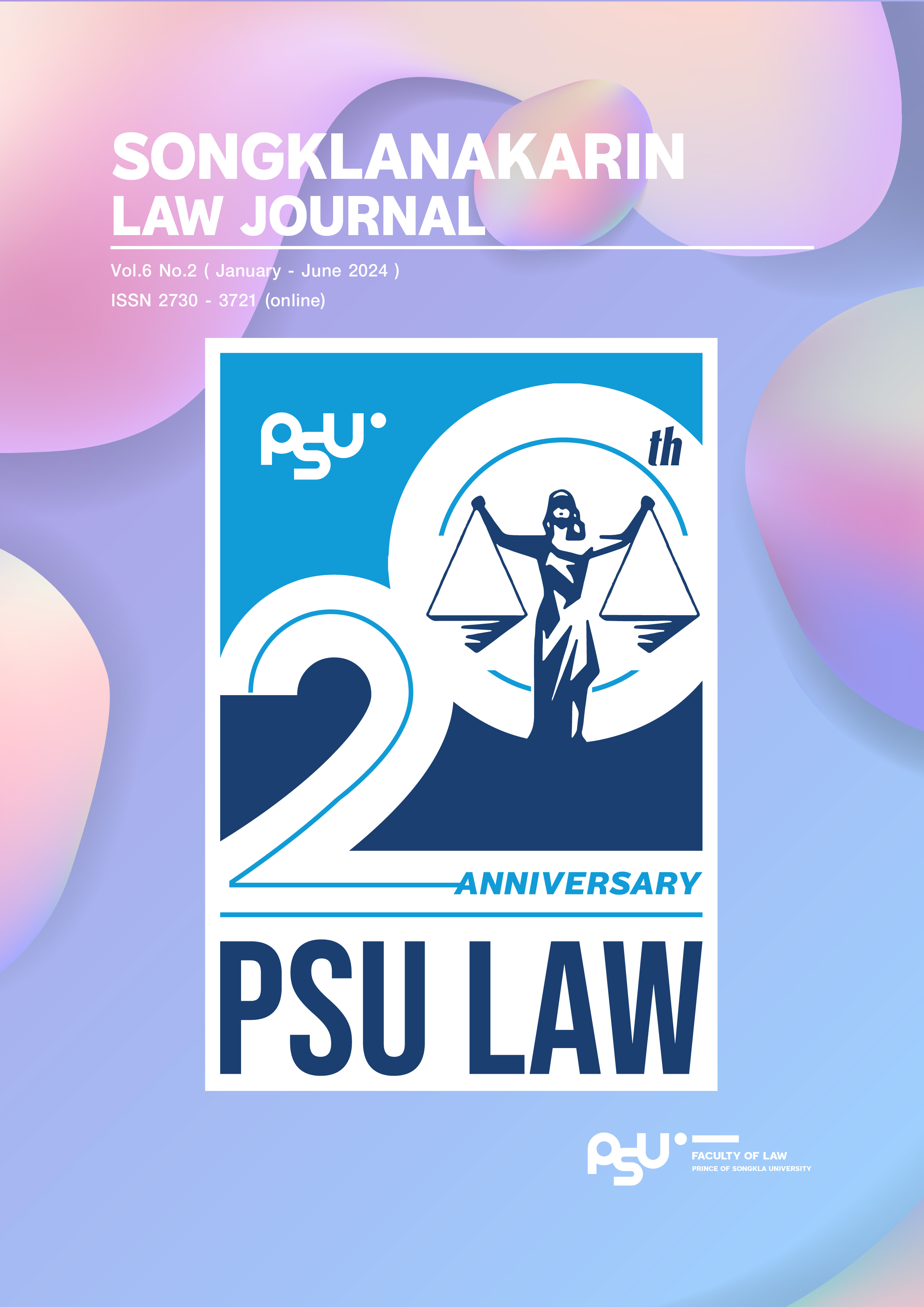การรับเข้ากฎหมายรัฐธรรมนูญ: ข้อความคิดและข้อพิจารณาเบื้องต้น
คำสำคัญ:
การรับเข้ากฎหมายรัฐธรรมนูญ, กฎหมายรัฐธรรมนูญเปรียบเทียบ, การกลายพันธุ์บทคัดย่อ
"การรับเข้ากฎหมายรัฐธรรมนูญ" เป็นปรากฏการณ์ที่เกิดขึ้นเป็นเรื่องปกติแทบทั่วโลกเมื่อมีการร่าง การปรับปรุงแก้ไข หรือการใช้การตีความกฎหมายรัฐธรรมนูญ การเรียนรู้จากผู้อื่นเป็นที่มาของความรู้และแรงบันดาลใจในการพัฒนาระบบการเมืองการปกครองของประเทศได้เป็นอย่างดี ในปัจจุบัน “ตลาดรัฐธรรมนูญโลก” เต็มไปด้วยตัวแบบและแหล่งอ้างอิงหลากหลายที่รัฐซึ่งต้องการปรับปรุงระบบกฎหมายรัฐธรรมนูญของตนสามารถจะเลือกหยิบยืมมาใช้เพื่อแก้ไขปัญหาที่ต้องประสบได้ อย่างไรก็ตาม กระบวนการการรับเข้านั้นเป็นเรื่องที่ซับซ้อนอันมีอุปสรรคและข้อจำกัดไม่น้อย อาทิ การต้องเข้าใจข้อมูลความรู้ที่เกี่ยวข้องกับข้อความคิดหรือสถาบันทางกฎหมายรัฐธรรมนูญที่เป็นตัวอย่างอย่างถ่องแท้ การปะทะระหว่างวัตถุที่รับเข้ามากับบริบทวัฒนธรรมทางกฎหมายของรัฐปลายทาง ตลอดถึงความเสี่ยงที่จะเกิดผลข้างเคียงไม่พึงประสงค์ทำให้กฎหมายรัฐธรรมนูญที่รับเข้ากลายพันธุ์ไป ด้วยเหตุนี้ บรรดาผู้มีส่วนเกี่ยวข้องจึงต้องคอยระมัดระวังและต้องพยายามตระเตรียมการให้ดีที่สุดสำหรับการหาสมดุลที่เหมาะสมระหว่างบริบทกฎหมายดั้งเดิมกับบรรทัดฐานหรือสถาบันทางกฎหมายใหม่ที่รับเข้ามา
เอกสารอ้างอิง
ปูนเทพ ศิรินุพงศ์. (2561). “สิทธิพิทักษ์รัฐธรรมนูญ” ในกฎหมายรัฐธรรมนูญไทย: การกลายพันธุ์ของความคิดทางรัฐธรรมนูญที่รับเข้าจากต่างประเทศ?. วารสารนิติศาสตร์ มหาวิทยาลัยธรรมศาสตร์, 47 (1), 81-108.
ปูนเทพ ศิรินุพงศ์. (2566). หัวมังกุท้ายมังกร: การผสมพันธุ์กฎหมายรัฐธรรมนูญที่รับเข้าจากต่างประเทศแบบผิดฝาผิดตัว. CMU Journal of Law and Social Sciences, 16 (2), 35-58.
Böckenförde, Markus, Hedling, Nora, and Wahiu, Winluck. A practical guide to constitution building (Stockholm: International IDEA, 2011). (2011). Retrieved April 10, 2024, from https://www.idea.int/sites/default/files/publications/a-practical-guide-to-constitution-building.pdf
Constitute. Retrieved April 10, 2024, from https://www.constituteproject.org/
Craig, Paul P. (2017). Transnational constitution-making: The contribution of the Venice Commission on Law and Democracy. The UC Irvine Journal of International, Transnational, and Comparative Law, 2 (2), 156-187.
Dixon, Rosalind, and Landau, David. (2019). 1989–2019: From democratic to abusive constitutional borrowing. International Journal of Constitutional Law, 17 (2), 489-496.
Fedtke, Jörg. (1996). Die Rezeption von Verfassungsrecht: Südafrika 1993 – 1996. Baden-Baden : Nomos.
Frankenberg, Günter. (2014). Verfassungstransfer. In Philipp Dann, Stefan Kadelbach, and Markus Kaltenborn (Eds.), Entwicklung und Recht, pp. 589-618. Baden-Baden : Nomos.
Frankenberg, Günter. (2010). Constitutional transfer: The IKEA theory revisited. International Journal of Constitutional Law, 8 (3), 563-579.
Gordon, Mitchell. (2009). Don't copy me, Argentina: Constitutional borrowing and rhetorical type. Washington University Global Studies Law Review, 8 (3), 487-519.
Graziadei, Michele. (2006). Comparative law as the study of transplants and receptions. In Mathias Reimann and Reinhard Zimmermann (Eds.), The Oxford Handbook of Comparative Law, pp. 441-476. New York : Oxford University Press.
Groppi, Tania, and Ponthoreau, Marie-Claire. (2013). The use of foreign precedents by constitutional judges. USA : Hart.
Häberle, Peter. (2004).Wechselwirkungen zwischen deutschen und ausländischen Verfassungen. In Detlef Merten and Hans-Jürgen Papier (Eds.), Handbuch der Grundrechte in Deutschland und Europa. Band I: Entwicklung und Grundlagen, pp. 313-348. Heidelberg : C.F. Müller.
Häberle, Peter. (1992). Theorieelemente eines allgemeinen juristischen Rezeptionsmodells. JuristenZeitung, 47 (21), 1033-1043.
Harding, Andrew. (2019). The legal transplants debate: Getting beyond the impasse?. In Vito Breda (Ed), Legal Transplants in East Asia and Oceania, pp. 13-33. Cambridge : Cambridge University Press.
Hartwig, Matthias. (1999). Die Legitimation des Staates durch Verfassungsrezeption in Mittel- und Osteuropa. Zeitschrift für ausländisches öffentliches Recht und Völkerrecht, 59, 919-939.
Horwitz, Morton J. (2009). Constitutional transplants. Theoretical Inquiries in Law, 10 (2), 535-560.
Hupper, Gail J. (2008). The academic doctorate in law: A vehicle for legal transplants?. Journal of Legal Education, 58 (3), 413-454.
Kanda, Hideki, and Milhaupt, Curtis J. (2003). Re-Examining legal transplants: The director's fiduciary duty in Japanese corporate law. The American Journal of Comparative Law, 51 (4), 887-901.
Kramer, Ernst A. (2017). Hauptprobleme der Rechtsrezeption. JuristenZeitung, 72 (1), 1-11.
Law, David S., and Versteeg, Mila. (2012) The declining influence of the United States Constitution. New York University Law Review, 87 (3), 762-858.
Legrand, Pierre. (1997). The impossibility of ‘legal transplants’. Maastricht Journal of European and Comparative Law, 4 (2), 111-124.
Ludwikowski, Rett R. (1998). ‘Mixed’ constitutions: Product of an East-Central European constitutional melting pot. Boston University International Law Journal, 16 (1), 1-70.
Miller, Jonathan M. (2003). A typology of legal transplants: Using sociology, legal history and Argentine examples to explain the transplant process. The American Journal of Comparative Law, 51 (4), 839-885.
Mössner, Jörg Manfred. (1974). Rechtsvergleichung und Verfassungsrechtsprechung. Archiv des öffentlichen Rechts, 99 (2), 193-242.
Nelken, David. (2001). Towards a sociology of legal adaptation. In David Nelken and Johannes Feest (Eds.), Adapting Legal Cultures, pp. 7-54. Oxford : Hart Publishing.
Nußberger, Angelika. (2010). Verfassungsrechtstransfer von West nach Ost: Illusion, Desillusion, Neubeginn. Osteuropa, 60 (9), 81-96.
Örücü, Esin. (2002) Law as transposition. The International and Comparative Law Quarterly, 51 (2), 205-223.
Perju, Vlad. (2012). Constitutional transplants, borrowing, and migrations. In Michel Rosenfeld and András Sajó (Eds.), The Oxford Handbook of Comparative Constitutional Law, pp. 1304-1327. New York : Oxford University Press.
Rehm, Gebhard M. (2008). Rechtstransplantate als Instrument der Rechtsreform und -transformation, Rabels Zeitschrift für ausländisches und internationales Privatrecht, 72 (1), 1-42.
Saunders, Cheryl. (2020). Transplants in public law. In Mark Elliott, Jason NE Varuhas, and Shona Wilson Stark (Eds.), The Unity of Public Law?, pp. 257-278. Oxford : Hart Publishing.
Saunders, Cheryl. (2019). International involvement in constitution making. In David Landau and Hanna Lerner (Eds.), Comparative Constitution Making, pp. 69-89. Cheltenham : Edward Elgar Publishing.
Spector, Horacio. (2008). Constitutional transplants and the mutation effect. Chicago-Kent Law Review, 83 (1), 129-145.
Teubner, Gunther. (1998). Rechtsirritationen: Der Transfer von Rechtsnorm in rechtssoziologischer Sicht. In Jürgen Brand and Dieter Stempel (Eds.), Soziologie des Rechts: Festschrift für Erhard Blankenburg zum 60. Geburtstag, pp. 233-244. Baden-Baden : Nomos.
The Public International Law & Policy Group, Post-Conflict constitution drafter’s handbook. (2007). Retrieved April 10, 2024, from https://peacemaker.un.org/sites/peacemaker.un.org/ files/ PostConflictConstitutionDraftersHandbook_PILPG2007.pdf
Tushnet, Mark. (1999). The possibilities of comparative constitutional law. The Yale Law Journal, 108 (6), 1225-1309.
Watson, Alan. (1993). Legal transplants: An approach to comparative law. 2th ed.. Athens : University of Georgia Press.
Zada, Sebghatullah Qazi, and Ansari, Abdul Haseeb. (2015). Legal transplant and the ‘dialogue of deaf’: Revisiting the debate between transferists and culturalists. The NUSRL Journal of Law & Policy, 2 (2), 41-60.
ดาวน์โหลด
เผยแพร่แล้ว
ฉบับ
ประเภทบทความ
สัญญาอนุญาต
ลิขสิทธิ์ (c) 2024 วารสารกฎหมายสงขลานครินทร์

อนุญาตภายใต้เงื่อนไข Creative Commons Attribution-NonCommercial-NoDerivatives 4.0 International License.
ลิขสิทธิ์ในบทความที่ตีพิมพ์เผยแพร่เป็นของวารสารกฎหมายสงขลานครินทร์ วารสารกฎหมายสงขลานครินทร์มีสิทธิในการเผยแพร่ ทำซ้ำ หรือรวบรวมบทความที่ตีพิมพ์เผยแพร่แล้ว ความคิดเห็นใด ๆ ของผู้เขียนในบทความ กองบรรณาธิการวารสารไม่จำเป็นต้องเห็นพ้องด้วย ทั้งนี้กองบรรณาธิการวารสารไม่สงวนสิทธิในการคัดลอกแต่ให้อ้างอิงแหล่งที่มาด้วย



